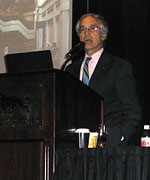
The first-ever combined conference and exposition drew a number of industry professionals, who were interested in learning more about filtration and indoor air quality (IAQ) issues. Attendees could choose to participate in a number of different workshops, panel discussions, and technical sessions, as well as visit the exhibits displayed by numerous manufacturers.
Three tracks ran simultaneously at the conference. The first track, "IAQA: Assessment," incorporated workshops including fungal assessments, forensic evaluation of mold, and EPA's new voluntary indoor air quality label for homes.
Track two, "IAQA: Remediation," included seminars concerning inspection and maintenance standards, stopping mold growth, and mold regulation.
The third track, "NAFA: HVAC," included speakers discussing HVAC system performance, life-cycle costing for air filters, and the effects of residential air cleaners on indoor particulate levels. Needless to say, there was a plethora of information available for everyone attending this conference.

IAQ In Schools
The seminar titled "Indoor Air Quality in Schools: A Benchmark Study of High Performance Schools" was of particular interest. Mark Sanders, P.E., vice president of Marcor Remediation, Austin, Texas, discussed the results of the study he performed with Richard Corsi and Vincent Torres, both from the University of Texas-Austin."We started this study in 2000 and concluded it in August 2001," noted Sanders. "Basically, we just wanted to see what indoor air quality looked like in a ‘normal' school in Texas. We also wanted to study the impact of construction practices on IAQ in schools - what's working or not working."
To that end, Sanders and his team studied the IAQ, health symptoms of occupants, and occupant perceptions in 30 elementary schools, which were considered to be the baseline. The same aspects were studied in three "high-performing" elementary schools.
In this case, high performing meant the schools utilized construction materials and/or methods that may not be found in average schools. These included such features as hard-surface flooring, pitched roofs, central HVAC systems, and sustainable design. Other features that marked high-performing schools included the use of natural light and materials that emitted low levels of volatile organic compounds (VOCs).
The three high-performing schools included two in Texas and one in New Hampshire. The New Hampshire school was included because it utilized a displacement ventilation system, which is not normally seen in schools.
Sanders and his team sent out numerous surveys to teachers, office staff, and other school personnel, and received approximately 1,500 responses. The surveys included questions regarding temperature, health problems, and ventilation.
Three walk-through surveys were then done to document the materials, design, condition, and cleanliness of the schools grounds, classrooms, and the HVAC system for each classroom selected.
Sanders showed numerous photographs from these surveys that revealed classrooms with stained ceilings from water damage, registers covered in plastic wrap, improper ductwork, blocked returns, open cans of paint near air intakes, and slime growing around HVAC components.

Extensive continuous monitoring was also performed on four randomly selected classrooms from each school. The first phase of monitoring involved temperature, relative humidity, and CO2, all of which were measured and logged using the same instrument. Two separate instruments were used to detect and log CO concentrations.
The second phase of monitoring included CO2, CO, temperature, and humidity, and each classroom was also sampled for microbes, particle counts, size analysis, and total VOCs.
As could probably be expected, the high-performing schools often fared better in terms of IAQ than their counterparts. In particular, Sanders and his team found the New Hampshire school to be exemplary in terms of IAQ, and they attributed much of this to its displacement ventilation system.
"This type of system works well because it has no drafts, is energy efficient, and results in improved ventilation," said Sanders.
Based on the information gathered, Sanders noted that roof leaks were the most common problem at all schools, remarking that leaks could lead to the proliferation of mold and IAQ concerns. To address this problem, he suggested the possible need for roof redundancy, so water penetrating one roof may not penetrate into the building itself.
If a redundant roof isn't a possibility, then Sanders suggested that pitched roofs may perform better than flat roofs.
"Often in schools with flat roofs, we'd see pools of water just sitting up there. The roofs were probably designed for the water to run off, but for whatever reason, that just wasn't happening."
Besides pitched roofs, roof redundancy, and displacement ventilation, Sanders and his team came up with the following construction techniques that could result in better IAQ in schools:

Coil Efficiency
Another interesting seminar given at the convention was titled "Heating and Cooling Coil Capacity and Efficiency." Thomas Jacobs, president of USA Coil and Air (www.usacoil.com), gave a lively talk concerning the need to keep coils clean. He noted that coils today are made differently than those made when he started in the business 30 years ago. "Coil wall thicknesses today are about half what they were previously. Fin surfaces are also half of what they used to be," said Jacobs.In addition, there are many more fins per inch than the 12 per inch Jacobs saw when he started in the industry in the 1970s. That, combined with enhanced fin surfaces, means that coils made today are very hard to clean and keep clean.
The problem is that the fins are so thin and fragile now that they're easily damaged, Jacobs said, so cleaning a coil must be done very carefully. Jacobs provided the following tips for how to clean a chilled water coil:
Jacobs proceeded to describe several applications in which the coils had not been cleaned in years, and the result was always the same: system failure. There also comes a point where cleaning will no longer be effective, he said, and, if that's the case, it's probably time to replace the coil.
More information about IAQA can be found at www.iaqa.org. For more information on NAFA, visit www.nafahq.org.
Publication date: 10/25/2004


